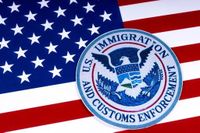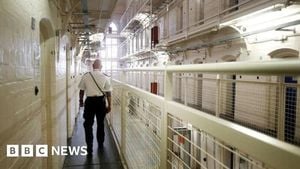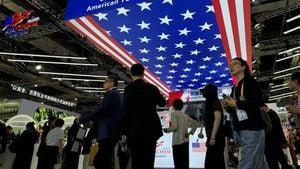The United States is facing a new wave of economic anxiety as President Donald Trump’s aggressive immigration crackdown coincides with a surge in inflation, leaving policymakers, business leaders, and everyday Americans grappling with rising costs and an uncertain outlook. At the heart of the debate is a question that’s as old as economics itself: are restrictive immigration policies fueling the nation’s inflation problem, or are they simply a scapegoat for deeper economic woes?
Since returning to the White House, President Trump has sealed off the southern border with Mexico, effectively stopping what officials estimate to be 10 million illegal immigrants who entered the country under President Joe Biden. The administration has also ramped up deportations, with an average of 750 immigrants reportedly being removed daily in 2025, according to Fortune and Benzinga. Thousands more are in detention, awaiting removal. The White House has hailed these actions as a necessary measure to protect American jobs and restore order to the border.
But critics warn that this strategy is coming at a steep price. Mark Zandi, chief economist at Moody’s, has emerged as one of the most prominent voices cautioning that the loss of cheap foreign labor is driving up prices across the economy. “If Trump continues deporting immigrants at the current rate, inflation will go from 2.5% to somewhere close to 4% by the time it hits its peak early next year,” Zandi told Fortune. He elaborated, “Foreign-born labor force is declining, and the overall labor force has gone flat since the beginning of the year. That’s causing tightening in a lot of markets, adding to costs and inflation.”
The latest data from the Labor Department appears to support Zandi’s concerns. The producer price index (PPI), a key measure of wholesale prices, jumped 0.9% from June to July 2025—the largest one-month increase since 2021. Meanwhile, the consumer price index (CPI) edged up 0.2% in July and now sits at 2.7% year over year. Rising costs are especially apparent in sectors that depend heavily on immigrant labor, such as construction, agriculture, food processing, and personal services like haircuts and dry cleaning.
“You can see it in meat prices, agriculture, food processing, haircuts, dry cleaning,” Zandi said, pointing to the fingerprints of restrictive immigration policy on the nation’s inflation gauges. According to Benzinga, prices for vegetables, meat, and other staples have all increased, while construction and elder care industries are also feeling the pinch.
The White House, however, is not buying the argument that its immigration crackdown is to blame for inflation. Abigail Jackson, a spokesperson for the administration, told The New York Post that the focus is on “protecting the American workforce” and making use of “untapped potential” at home. She cited data showing that more than one in ten young Americans are neither working nor in school, suggesting there is plenty of domestic labor available if given the right opportunities. “100% of job gains have gone to native-born American workers,” Jackson added, emphasizing the administration’s commitment to putting Americans first.
To address labor shortages, Trump signed an executive order in April 2025 aimed at modernizing workforce programs and expanding apprenticeships to prepare Americans for high-paying skilled trade jobs. The goal: support more than 1 million apprenticeships per year. Yet, the problem may be larger than even the most ambitious training programs can solve. The U.S. faced a shortfall of 447,000 construction workers and 94,000 durable goods workers in 2024, with the Bureau of Labor Statistics projecting an annual deficit of nearly half a million tradespeople over the next decade. As AI and manufacturing reshoring accelerate, demand for skilled labor is only expected to grow.
Not everyone in Trump’s camp is convinced the strategy will work. Steve Moore, an economist at the Heritage Foundation who has advised the president, admitted to The New York Post, “I’m worried about a labor shortage. I think the deportations of working illegal immigrants could have a slight impact on wages and thus prices.” Moore’s concerns echo those of other economists who fear that the labor market is tightening too quickly, with immigrants either leaving the country or choosing not to come at all due to the hostile climate.
“It’s the southern border being shut down, it’s deportations, it’s self-deportations,” Zandi explained. “Immigrants are scared. They’re leaving the country, they’re not coming in, they’re not going to work.”
Yet, others argue the story is more complicated. Some business leaders and economists point to a real pullback in labor demand as businesses cut back, citing shrinking payrolls in manufacturing, transportation, and warehousing, along with surveys showing fewer job openings. In their view, the main driver of inflation is weaker business confidence and softer consumer demand, not immigration policy alone. Zandi himself conceded, “The opposing camp sees a different story: a real pullback in labor demand as businesses cut back.”
The distinction isn’t just academic—it has real implications for Federal Reserve policy. If inflation is being driven by labor shortages caused by immigration restrictions, interest rate cuts won’t solve the problem. “Demand-side inflation has a different implication for monetary policy than supply-side inflation,” Zandi told Fortune. “Rate cuts won’t bring more immigrants into the country.” He warned that the inflationary impact of immigration restrictions will be harder to shake than tariffs, which are “more likely to be one-off.” Restrictive immigration, he argued, “adds to shortages, higher labor costs and wages—and that can become self-reinforcing.”
Financial markets are watching closely. While the S&P 500 remains near record highs on expectations of a September 2025 rate cut, bond traders are already bracing for a tougher Fed, pushing short-term Treasury yields higher. Bank of America economists have echoed the risk of stagflation—a toxic mix of stagnating growth and persistent inflation—saying it’s why they expect the Fed to hold rates steady this year.
Adding to the uncertainty, consumer sentiment has unexpectedly cooled in August 2025, as inflation concerns reemerged and weighed on household confidence, according to the University of Michigan’s Consumer Sentiment Index. Earlier in the summer, Deutsche Bank warned that the ongoing immigration crackdown could cause a more severe negative supply shock to the economy than Trump’s tariffs ever did. In early August, Zandi himself warned that the U.S. economy was “on the precipice of recession,” citing disappointing economic data releases.
With the nation’s economic future hanging in the balance, the debate over immigration, labor, and inflation shows no signs of cooling off. For now, Americans are left to navigate rising grocery bills, higher service costs, and a political climate where every policy choice seems to come with a hefty price tag.




